
| RELATED INFO |
| • List of top donors to the Computer Science Building |
| • Purdue College of Science |
| • Purdue Department of Computer Science |
September 15, 2006
Purdue dedicates new Lawson Computer Science Building
WEST LAFAYETTE, Ind. — Purdue University's computer science department, the first in the nation, rebooted its system on Friday (Sept. 15) with the dedication of the new Richard and Patricia Lawson Computer Science Building.

|
The dedication took place at the building, located at the corner of Third and University streets. The event will kicked a one-week celebration leading up to Purdue's Sept. 23 Homecoming. Events focus on ways Purdue is improving education and helping the state of Indiana as part of the university's strategic plan and $1.5 billion fund-raising campaign, which so far has garnered $1.426 billion.
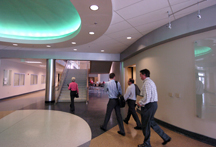
|
"This facility offers a superior environment to prepare students to lead the field," Richard Lawson said. "Graduates will go on to be faculty and researchers at internationally recognized organizations, as well as leaders and innovators in industry and government. Computer science is an important component of all disciplines, and embedding it into the larger Purdue environment is extremely valuable. The benefits will not be confined to computer science, but will extend beyond into all fields of study."
The university raised $7 million in private gifts from 289 donors to leverage an additional $13 million from the state of Indiana to fund the 100,000-square-foot-building.
The facility consolidates the computer science program from five buildings to two. All regular faculty in the Department of Computer Science will have offices in Lawson. The building provides meeting rooms and space for 45 faculty, 55 teaching assistants and 70 research assistants and houses four classrooms, five instructional labs and four research labs.
"The building is very inviting as well as offering access to the latest equipment," said Tim Korb, assistant department head of computer science. "The team project computer labs feature comfortable spaces for groups to collaborate and share ideas. Even the lobby invites interaction."
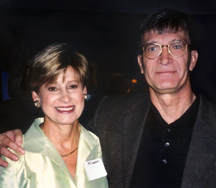
|
"Herman felt his education at Purdue helped him in all of his endeavors," Heddy Kurz said. "He wanted to give back to the university, and he always believed in good solid structures and the importance of high-quality research equipment."
The lobby features a display case with memorabilia from Heddy and Herman Kurz that includes Purdue pennants, badges from Herman's marching band uniform and photos from their past.
In addition to the meeting rooms, classrooms, and research and instructional labs, the facility includes the 100-seat University Meeting Room, a lecture hall designated for special events, and the adjacent commons area that offers a registration area, poster session area and space for a tiled video wall.
The commons was made possible by a gift from Michael Farmwald in honor of Dr. John Cocke, an American computer scientist involved in computer architecture and compiler technology.
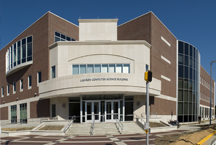
|
This special events space has already caught the attention of several conferences.
"With this new building, we offer a great capacity all in one space," Korb said. "We were selected to host TopCoder, an international programming competition for high school students. Other universities would have had to spread the conference out over several locations. Our campus already had so much to offer, and this building puts us over the top. These events increase traffic and bring greater recognition and opportunities to our campus."
Farmwald, a computer engineer and entrepreneur who received his degree in mathematics from Purdue in 1974, said such events bring in many potential supporters of research, employers for students, and attract top faculty and graduate students.
"It is also conducive to forming partnerships to help identify problems in the field and work towards a solution," he said. 'There are many exciting opportunities in the field of computer science, and this building provides an attractive and comfortable space to put scientists, students and the public together."
The building offers state-of-the-art equipment in addition to its interaction areas. It is wired with special 10-gigabit high-speed cable, 100 times faster than the standard Ethernet available throughout most of campus.
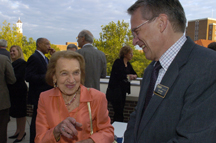
|
"Having a world-class facility also will help us to attract the best and brightest and will support our research community and students as we strive for excellence. Our graduate program already ranks 18th in the nation, and we are moving up."
The newly designed labs are specific to each group's area of study. For example, the Graphics and Visualization Lab provides an area to create a virtual world, Korb said.
"It is like the holideck from 'Star Trek'," he said. "It is a blank canvas able to become whatever researchers need. It allows them to almost completely control the environment. They can block outside interference, such as noise or light, to permit work with a highly sensitive machine, or it gives them the space to create virtual worlds."
Visualization applies to a broad range of research, said Daniel Aliaga, assistant professor of computer science.
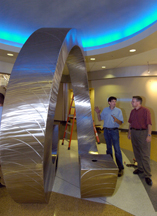
|
The Coordinated Systems Lab is outfitted with new computers and equipment essential to competitive research, said Ananth Grama, a professor in computer science.
"One of our main research areas is parallel computing systems," he said. "Without new computers that contain multiprocessor systems, we would be unable to perform the necessary tests to carry out our research. Access to these computers enables us to maintain our competitive edge in this important field."
The group's research benefits from interactions within the department made easier by the new building, he said.
"It brings together the people who write programs with the people who develop the infrastructure to support the programs, and both will be better because of it," Grama said. "Interactions lead to inspiration.
"Advances in computer science have many applications and affect a broad range of fields. We are involved in high-fidelity simulations ranging from corrosion-resistant materials to models of biological processes to speed research and development in the life sciences."
An advance in computing power directly impacts a broad range of disciplines. Such systems are found everywhere, including in the control systems of cars and household appliances, said Susanne Hambrusch, head of the computer science department.
"Computer science is no longer an esoteric field with applications unseen by the general public," she said. "Many of us use portable computing devices made pocket-sized by advances in computer chip technology. We are all familiar with search engines and databases, concerned about the privacy of our information on the Internet and in company networks, and are entertained and impressed by computer graphics and animation. This is all rooted in computer science."
The databases group is a good example of the interdisciplinary nature of research because the group performs the majority of its research in collaboration with other departments, said Ahmed Elmagarmid, director of Purdue's Cyber Center and a professor of computer science.
"We are currently working with groups from biology, nursing, engineering, business, chemistry and statistics, and with groups outside of Purdue including the Indiana University Medical School," he said. "No matter who you talk to, everyone has database problems."
Elmagarmid, who also is director of the Indiana Center for Database Systems, described a research project for the Purdue University Regional Visualization and Analytics Center.
"We are currently developing a system to predict disease epidemic and pandemic outbreaks," he said.
Information is gathered from many sources such as hospital admissions, emergency room visits, and over-the-counter drug sales. This data is correlated with veterinary hospitals' data of illnesses in pets and the geographic location from where the data came, Elmagarmid said.
"Through analysis of this massive amount of data, a process known as visual analytics, the system can detect if an outbreak is brewing," he said. "It will allow the health department to predict an epidemic, for example a flu outbreak."
The Secure and Distributed Systems Lab also relies on interaction across disciplines. It is involved in projects to improve identity theft prevention, collaboration and shared computer power among universities, encryption techniques, and network and database security.
"Interaction with other groups is key to getting new research ideas," said Elisa Bertino, research director of the Center for Education and Research Information Assurance and Security and a professor of computer science. "It reminds us that computer science research is not just technical. We must take into account the social aspect.
"We work with the College of Technology and the College of Consumer and Family Sciences to better understand how to use biometric data, such as fingerprints, for identification purposes and to study how accepting society will be of moving in this direction. Privacy has a lot of issues concerning the support and enforcement of policies. We have to deal not only with the technical, computer science side, but also the organizational aspects. It spans several disciplines."
The new building also supports the "living lab" concept instituted by Purdue.
"We use the research going on here in our day-to-day business," Korb said. "We use the network technology developed by our groups and allow students hands-on access to all that goes on here. Each floor has a closet walled with windows revealing exposed wiring to show students the connections and arrangement. Windows into our machine rooms full of equipment and our 1,000-square-foot data center provide students insight into the inner workings of powerful computing operations."
At the new team projects lab, students will be able to collaborate on projects.
"These special work stations, with five computers feeding into a central display, engage all students within a team," Korb said. "Each can contribute to the project simultaneously. Without these stations, five students would be crowded around one computer and only one student would be physically interacting with the computer.”
A soundproof video production facility will be used by students to add voiceovers to projects, create expositions of research works and allow professors to record lectures and training materials.
Kurz said the building is even better than she imagined.
"It's got a lot of style," she said.
Writer: Elizabeth Gardner, (765) 494-2081, ekgardner@purdue.edu
Sources: Jeffrey S. Vitter, (765) 494-1730, dean@science.purdue.edu
Tim Korb,(765) 494-6184 jtk@cs.purdue.edu
Susanne Hambrusch, (765) 494-1831, seh@cs.purdue.edu
Ahmed Elmagarmid (765) 494-1998, ake@cs.purdue.edu
Elisa Bertino, (765) 496-2399, bertino@cerias.purdue.edu
Ananth Grama, (765) 494-6964, ayg@cs.purdue.edu
Daniel Aliaga, (765) 496-7943, aliaga@cs.purdue.edu
Purdue News Service: (765) 494-2096; purduenews@purdue.edu
Note to Journalists: Video b-roll of the building and students in classrooms and labs is available by contacting Jesica Webb, Purdue News Service, at (765) 494-2079, jwebb@purdue.edu.
PHOTO CAPTION:
Patricia Lawson, at center, speaks with Purdue first lady Patty Jischke on Thursday (Sept. 14) during a prededication event at the Lawson Computer Science Building. Richard Lawson, at right, explains the computer display on the "Echo Spiral" sculpture to his granddaughter Sammi Lawson, 9, while Danni Lawson, 5, plays on the sculpture. (Purdue News Service photo/David Umberger)
A publication-quality photo is available at https://www.purdue.edu/uns/images/+2006/lawsons-sculpture.jpg
PHOTO CAPTION:
The Herman and Heddy Kurz Lobby exhibits the state-of-the-art design and open atmosphere of Purdue's new Lawson Computer Science building. (Purdue News Service photo/David Umberger)
A publication-quality photo is available at https://www.purdue.edu/uns/images/+2006/lawson-lobby.jpg
PHOTO CAPTION:
Heddy Kurz talks with Tim Korb, assistant head of the Department of Computer Science, on Thursday (Sept. 14) while standing on the Tolopka Terrace of the Lawson Computer Science Building. (Purdue News Service photo/David Umberger)
A publication-quality photo is available at https://www.purdue.edu/uns/images/+2006/kurz-lawsontour.jpg
PHOTO CAPTION:
Indiana artist John Mishler, from left, and Tim Korb, assistant head of Purdue's Department of Computer Science, discuss the installation of Mishler's sculpture in the lobby of the new Lawson Computer Science Building. (Purdue News Service photo/David Umberger)
A publication-quality photo is available at https://www.purdue.edu/uns/images/+2006/lawson-sculptureinstall.jpg
To the News Service home page